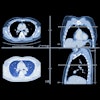A recent study in the Journal of the American College of Cardiology raises important questions about the role of race in the accumulation of coronary artery calcium (CAC), as well as its association to cardiovascular incidents.
In the study, cardiologists and radiologists at the Walter Reed Army Medical Center in Washington, DC, found that while black Americans had a worse cardiovascular profile than whites, the former also had significantly less coronary artery calcium (JACC, January 2003, Volume 41:1, pp. 39-44).
The study has important implications for radiologists involved in CT calcium scoring. As screening programs begin to engage radiologists increasingly in patient care, the advice radiologists offer with their results can make a crucial difference in their patients' prognosis.
Other radiologists are working to assess the meaning of calcium scores, evaluate the relationship between coronary artery calcium and adverse events, and refine the traditional Agatston scoring method in efforts to improve its reliability as a predictor of disease.
The uncertain link between calcium and race
"Previous studies on race and CAC have yielded discrepant results," wrote Dr. Timothy Lee and colleagues. "In a study using digital fluoroscopy, Doherty et al found a significantly lower prevalence of CAC yet higher cardiovascular event rates in black individuals. More recently, the Coronary Artery Risk Development in Young Adults study (CARDIA) reported an absence of racial differences in the prevalence and severity of coronary artery calcification using coronary CT. Thus, additional data are needed to clarify the relationship between race and CAC" (JACC, September 1999, Vol. 34:3, pp. 787-794; and Arteriosclerosis, Thrombosis and Vascular Biology, May 2001, Vol. 21, pp. 852-857).
The group examined 1,000 consecutive participants in a narrow age range of 40-45 years (mean age, 42 ± 2 years), 999 of whom underwent coronary CT calcium screening. All of the subjects had indicated a specific racial affiliation, including 699 non-Hispanic whites (69.9%) and 194 blacks (19.4%).
Lee and his colleagues performed coronary CT in the subjects using an Imatron C-150LXP electron beam CT scanner (GE Medical Systems, Waukesha, WI). Forty to fifty 3-mm slices were acquired in each patient during a single breath-hold, using cardiac gating at 70%-80% of the RR interval. An experienced radiologist read the scans, and determined a total CAC score by adding the individual scores from the four major epicardial coronary arteries using the Agatston scoring method.
The subjects had provided detailed medical histories, including known diagnoses of cardiac risk factors such as hypertension, diabetes, hyphercholesterialemia, and history of tobacco use. The researchers calculated waist girth and body mass, testing blood at fasting for a variety of substances with a univariate association to cardiovascular risk.
Electrocardiograms and low-density lipoproteins were also measured. Risk factors with a univariate relationship to coronary calcium were included in the model, as were socioeconomic status or military rank, and educational level (blacks were likelier than whites to be current smokers, and likelier to have hypertension).
According to the results, CAC was present in 17.3% of subjects overall, including 19.2% of whites versus 10.3% of blacks. Overall, CAC was associated with body-mass index, waist girth, diastolic blood pressure, HDL, triglyceride levels, hemoglobin, A1C, lipoprotein and fibrinogen.
"Coronary artery calcium was more common in both white men (trend: p=0.06 and white women (p = 0.02)," the authors wrote. "Overall, the mean CAC score was also significantly higher for black subjects. No black woman had detectable CAC, and the mean CAC score was significantly higher in white women (p=0.03)."
Even when the investigators entered univariate associations between race and cardiovascular risk into a logistic regression model for CAC to control for race and socioeconomic status, BMI and serum triglycerides remained statistically significant predictors of CAC (p < 0.05), according to the authors. The odds ratio for CAC in blacks was 0.39 (0.20 to 0.78), at 95% confidence interval, p=0.007.
Assessing the results
"The biologic basis for differences between black and white subjects in the presence of preclinical atherosclerosis is partly founded in major interracial differences in cardiovascular risk factors," the group wrote. "Whereas hypertension, diabetes, and obesity are more prevalent in black individuals, lipid profile abnormalities (particularly lower HDL cholesterol and higher triglyceride levels) are more prevalent in whites.
However, current evidence from pathology studies of early atherosclerosis and ultrasound studies of carotid intima-media thickness in asymptomatic individuals indicate that, after controlling for differences in risk factors and socioeconomic status, race does not have an independent relationship to atherosclerosis."
At the same time, it would be a mistake to assume that coronary calcification is a race-independent phenomenon, the authors cautioned. After all, they wrote, Doherty and colleagues found more calcification among whites even after adjusting for cardiovascular risk factors. Another study showed that very elderly blacks were less likely than whites to have CAC, even after adjusting for age differences between racial groups, the authors wrote.
In contrast, the CARDIA study did not find significant CAC differences between the races, but the study's reliance on younger patients, as well as the prevalence of obesity-related CT scan artifacts, may have skewed the results, the authors wrote.
That CAC distributions can be evenly generalized to all racial groups is an incorrect assumption, the group concluded. "Currently available data in populations ranging from middle-aged to the elderly support that this assumption is incorrect, based on the substantially lower prevalence of CAC, but not necessarily lower rates of incident cardiovascular events, in blacks compared with whites."
The Multi-Ethnic Study of Atherosclerosis (MESA) is expected to provide additional insight on questions surrounding race and heart disease. The study will screen some 6,500 men and women -- Asian, black, Hispanic, white -- ages 45-84, who are asymptomatic for cardiovascular disease at baseline.
By Eric BarnesAuntMinnie.com staff writer
February 17, 2003
Related Reading
Thin-collimation MDCT identifies more coronary calcium, December 18, 2002
Population-based study links coronary calcium and mortality, December 1, 2002Technology keeps CT vital for coronary assessment, November 13, 2002
CT calcium scoring works, but what does it mean?, January 8, 2002
Copyright © 2003 AuntMinnie.com




















